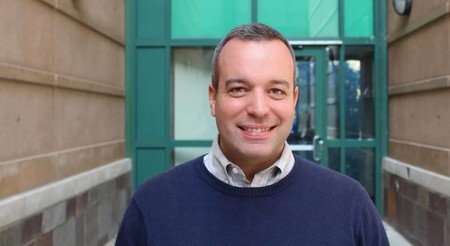De ongekende mogelijkheden van RNA structuren
Het menselijke genoom bevat ruim twintigduizend genen die zorgen voor de aanmaak van eiwitten. Maar het produceert minstens tien keer zoveel niet-coderende RNA moleculen, die vaak verschillende structuren kunnen vormen. Ten minste een deel van dit ‘RNA structuroom’ heeft ook een functie, of veroorzaakt ziekten. Danny Incarnato, moleculair geneticus aan de RUG, schreef daarover op verzoek van Nature Review Genetics een overzichtsartikel, samen met zijn collega Robert C. Spitale van de universiteit van Irvine, Californië (VS). Hierin beschrijven zij de nog weinig gebruikte potentie van de RNA structuren. Hun artikel is gepubliceerd op 8 november.
RNA is vooral bekend als de boodschapper tussen genoom en de productie van eiwitten: het boodschapper-RNA is een kopie van de genetische code van een gen uit de celkern, die de zogeheten ribosomen gebruiken als bouwinstructie voor een eiwit. Er zijn echter ook RNA moleculen die niet coderen voor een eiwit, maar betrokken zijn bij het reguleren van allerlei processen in de cel. De structuur die deze zogeheten niet-coderende RNA moleculen aannemen lijkt vaak doorslaggevend voor de functie die ze hebben.

Functie
Danny Incarnato, assistent-hoogleraar moleculair genetica, is al langer geïnteresseerd in de rol van RNA-structuren in de cel. Hij werkt onder meer aan methoden om de verschillende structuren in levende cellen te kunnen onderscheiden. Dus toen hem gevraagd werd een overzichtsartikel over RNA-structuren te schrijven was dat een kolfje naar zijn hand. ‘En ik heb direct mijn vriend en collega Robert Spitale gevraagd om daar aan mee te werken. Hij is een van de pioniers van de RNA-revolutie.’
De laatste jaren is onze kennis over RNA moleculen in de cel enorm toegenomen. Het ENCODE project liet zien hoeveel niet-coderend RNA er in cellen aanwezig is; bij mensen is dat tien keer zoveel als het aantal voor eiwitten coderende genen. ‘Die hebben zeker niet allemaal een functie’, benadrukt Incarnato. ‘Maar veel hebben dat wel. En we weten nog maar heel weinig over de variatie aan RNA moleculen.’
Schakelaar
Verschillende soorten niet-coderend RNA zijn al veel langer bekend en daarvan weten we dat hun structuur vaak belangrijk is voor hun functie. Een voorbeeld zijn de zogeheten ribo-schakelaars: RNA moleculen die van vorm veranderen in reactie op veranderingen in de omgeving, waardoor ze de activiteit van genen kunnen beïnvloeden. ‘We wisten ook al dat RNA moleculen kunnen werken als enzymen’, zegt Incarnato. ‘En ribosomen, de eiwitfabriekjes van de cel, bestaan ook uit RNA.’ De RNA moleculen kunnen dus dienst doen als sensor, katalysator, schakelaar of bouwsteen in de cel, en een rol spelen bij de eiwitproductie maar ook de afbraak van RNA en de herschikking van genetische informatie voor eiwitproductie (splicing).

Geneesmiddel
Het is daarom niet verrassend dat er momenteel veel onderzoek plaatsvindt naar RNA als geneesmiddel. Een probleem daarbij is dat onze kennis van het ‘structuroom’, al de verschillende RNA structuren die er zijn, beperkt is. ‘We hebben tot nu toe vooral gekeken naar enkelvoudige structuren. Maar RNA moleculen zijn heel dynamisch, moleculen met dezelfde bouw kunnen totaal verschillende structuren hebben’, legt Incarnato uit. ‘Door de manier waarop we de structuur bepalen bestaat die vaak uit een gemiddelde van alle mogelijke structuren van een molecuul.’
Coronavirus
Incarnato is pionier in de methoden om de heterogeniteit aan structuren van RNA moleculen te bepalen. ‘We kunnen grootschalige bepaling van de bouwstenen van RNA combineren met het beschrijven van structurele verscheidenheid.’ In sommige gevallen zijn die verschillen toevallige bijproducten van de evolutie die nergens toe dienen, terwijl ze in andere gevallen wel functioneel zijn. Incarnato: ‘Op die manier kunnen RNA moleculen praktisch alles in een cel reguleren. Daardoor spelen ze een rol in gezondheid en ziekte.’
Hoewel de ontwikkelingen in het veld snel gaan, is de vooruitgang niet heel erg geordend. Incarnato: ‘Er vindt al toegepast geneesmiddelenonderzoek plaats naast een heleboel fundamenteel werk.’ Beïnvloeding van RNA’s kan een belangrijke manier zijn om ziekten te bestrijden, inclusief ziekten veroorzaakt door RNA virussen als het coronavirus SARS-CoV2. ‘Alleen hebben we geen idee van de ongewenste effecten van zo’n beïnvloeding. Voor stofjes die bepaalde enzymen blokkeren, zoals kinasen, zijn er allerlei profielen bekend van enzymen die er op lijken zodat je het gevaar van ongewenste kruisreacties kunt inschatten. Bij RNA structuren weten we niet hoeveel er een vergelijkbare vorm hebben. Daarom is er een duidelijk overzicht nodig van het structuroom, het geheel aan RNA structuren.’

Software
Nog een probleem is dat het in veel gevallen onmogelijk is te achterhalen welk van de structurele varianten van een specifiek RNA molecuul verantwoordelijk is voor het functioneren ervan – of voor het niet-functioneren. ‘Bovendien kunnen RNA’s met elkaar reageren en zo complexe regelnetwerken vormen. We zullen ons begrip van hoe dit in de cel werkt dus nog flink moeten verdiepen.’
Er is dus nog heel wat werk te verzetten. En daarbij speelt software een belangrijke rol: computerprogramma’s zijn nodig om biochemische analyses van RNA om te zetten naar structuren. Incarnato: ‘In dit onderzoeksveld moet je net zoveel weten over computercode als over hoge snelheid RNA analyse. Iedereen heeft dan ook ervaring in ‘natte laboratoria’ en in bio-informatica.’
Referentie: Robert C. Spitale & Danny Incarnato: Probing the dynamic RNA structurome and its functions. Nature Reviews Genetics, 8 november 2022
Meer nieuws
-
11 december 2025
Stormachtige planeten en een onverwachtse atmosfeer
-
09 december 2025
RUG-hoogleraar bij COP30: ‘Het is altijd drama’
